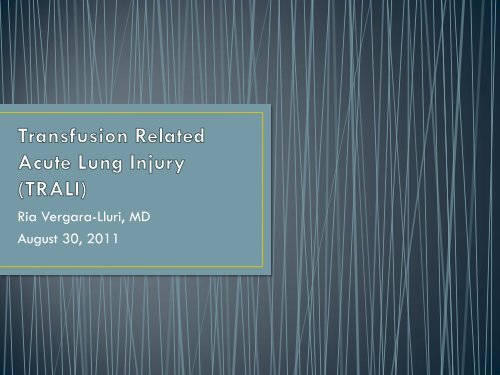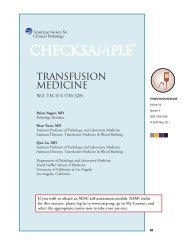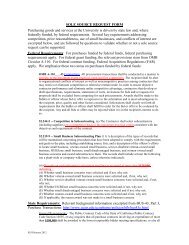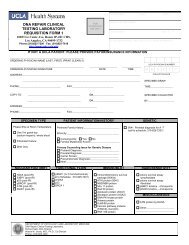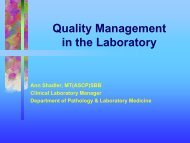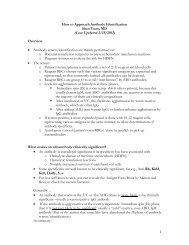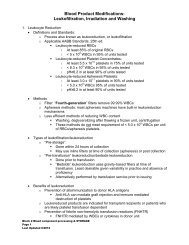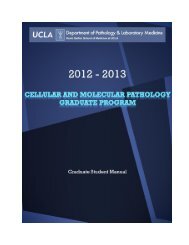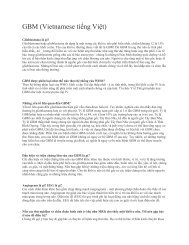by Dr. Ria Vergara-Liuri. UCLA Pathology Resident, last updatesd 8 ...
by Dr. Ria Vergara-Liuri. UCLA Pathology Resident, last updatesd 8 ...
by Dr. Ria Vergara-Liuri. UCLA Pathology Resident, last updatesd 8 ...
Create successful ePaper yourself
Turn your PDF publications into a flip-book with our unique Google optimized e-Paper software.
<strong>Ria</strong> <strong>Vergara</strong>-Lluri, MD<br />
August 30, 2011
• Case Presentation<br />
• Criteria for Diagnosis<br />
• Epidemiology<br />
• Pathogenesis<br />
• Management & Prognosis<br />
• Summary
• 50 year old man with Marfan syndrome and valvular<br />
cardiomyopathy<br />
• Admitted for orthotopic heart transplantation (OHT)<br />
• Blood type: AB negative<br />
• Multiple transfusions in the past for multiple surgical procedures
• INR 2.9 -- Surgical team requested 2 (to 4) units of FFP<br />
• 1 unit of FFP issued<br />
• 1 hr 15 mins (275 mL volume transfused):<br />
• Feeling badly and shivering – transfusion stopped<br />
• Pre-transfusion: T 36.3 C, BP 125/72, pulse 64, RR 18<br />
• Post-transfusion: T 35.8 C, BP 166/79, pulse 76, RR 18
• Benadryl and Tylenol given<br />
• Patient reported shortness of breath 87% O2 sat room air<br />
• Placed on 4L of oxygen on nasal cannula 96% O2 sat NC<br />
later placed on BiPap<br />
• Patient looked anxious and continued to have shortness of<br />
breath<br />
• Repeated administration of Lasix iv no improvement
• Blood Bank notified of reaction 6 hours afterwards (work-up)<br />
• Clerical check – pass<br />
• Visual hemolysis check – pass<br />
• DAT – negative<br />
• Patient brought to OR for transplant but given the continued<br />
hypoxemia procedure discontinued<br />
• CXR ordered
PRE-TRANSFUSION<br />
POST-TRANSFUSION
• Acute onset (
• A. Acute lung injury (ALI)<br />
• I. Acute onset<br />
• II. Hypoxemia<br />
• PaO2/FiO2 < 300, or SpO2
Learning Points:<br />
1. Clinicians don’t recognize cases as potential TRALI usually<br />
no BB transfusion work-up initiated<br />
2. Respiratory symptoms are mild no CXR performed<br />
3. Cases may not fit strict definition of TRALI (may underestimate<br />
TRALI incidence)<br />
4. Transfusions were not indicated<br />
Davis et al. Transfusion 2008;48:541-545.
• Incidence 1:3300 to 1:7900 in U.K. and U.S.<br />
• #1 cause of transfusion mortality in U.S.<br />
• Current mortality rates vary ~5-10%<br />
• Blood products w/ large amounts of plasma<br />
• Female donor<br />
• Female donor with at least 1 pregnancy<br />
Gajic O, et al. Am J Respir Crit Care Med 2007;176:886-891.<br />
Popovsky M, Davenport RD. Transfusion 2002;41:312-315.
http://www.fda.gov/BiologicsBlood/Vaccines/SafetyAvailability/ReportaProblem/TransfusionDonationFatalities/ucm204763.htm
Red Cross estimated<br />
risk of fatal TRALI per<br />
component<br />
Plasma 1:202,673<br />
Apheresis platelets<br />
1:320,572<br />
RBCs 1:2,527,437<br />
http://www.fda.gov/BiologicsBlood/Vaccines/SafetyAvailability/ReportaProblem/TransfusionDonationFatalities/ucm204763.htm
• Anti-neutrophil antibodies:<br />
• Antibodies in donor plasma react with antigens on recipient’s neutrophils<br />
initiate inflammatory response in lung microvasculature (less commonly<br />
recipient plasma reacts to donor granulocytes)<br />
• Neutrophil priming:<br />
• Lipids and cytokines contained in transfusions have ability to prime the<br />
activity of neutrophils increased vessel permeability<br />
• Two-event hypothesis (composite theory):<br />
• Recipient neutrophils are primed (<strong>by</strong> transfused active substances or <strong>by</strong><br />
patient’s underlying illness)<br />
• Transfused antibodies then “activate” hyperactive neutrophils
Shaz BH, et al. Blood 2011;117:1463-1471.
Shaz BH, et al. Blood 2011;117:1463-1471.
Supportive studies:<br />
• 65-90% of TRALI cases implicated<br />
donors have leukocyte Abs (HLA &<br />
HNA Ab)<br />
• Incidence of Ab increase with # of<br />
pregnancies<br />
Antibody-mediated<br />
TRALI (theory #1)<br />
TRALI lookback studies:<br />
• 103 recipients of donor w/ multiple<br />
HLA class I & II Abs only 1 TRALI<br />
case, even though 54/55 patients had<br />
cognate antigens<br />
• TTP pt developed TRALI after RBC<br />
transfusion from a donor w/ multiple<br />
anti-neutrophil Abs 0/21 previous<br />
donations resulted in txf reaction
Normal/Control mouse lung Mouse with LPS Mouse with LPS + MHC Ab<br />
• TRALI induced with both LPS + MHC Ab, but not with LPS or<br />
MHC Ab alone<br />
Data not shown:<br />
• Mice in pathogen-free barrier room + MHC Ab = no TRALI<br />
• Introduce mice to LPS (pathogen) + MHC Ab = TRALI<br />
Looney et al. J Clin Invest 2009;119:3450-3461.
Host genetic susceptibility<br />
C3 regulation<br />
Antigen expression<br />
on vessels & WBCs<br />
Cytokine<br />
responsiveness<br />
FATAL<br />
Clinical comorbidities<br />
Impaired hemostasis<br />
LVEDP<br />
Pulm infxn<br />
Preexisting hypoxia<br />
Capillary leak<br />
Moderate to<br />
severe<br />
Moderate to<br />
severe<br />
Mild<br />
Donor factors inducing TRALI<br />
Antibody titer, subclass, affinity, specificity, dose, rate of infusion<br />
Davis et al. Transfusion 2008;48:541-545.
• Prompt response is necessary to quarantine units and avoid<br />
additional patient exposure to donor<br />
• Supportive ventilatory therapy<br />
• Mechanical ventilation, supplemental oxygen<br />
• Usually resolves in ~72 hours<br />
• Can receive additional blood products in the future<br />
• Spectrum from mild to severe<br />
• Can lead to death in ~5-10% of cases
• Avoid unnecessary transfusions<br />
• Produce FFP only from male donors<br />
• Screen previously pregnant and previously transfused apheresis<br />
donors for HLA antibodies<br />
• Exclude donors with high HLA antibody titers
• TRALI should be considered whenever shortness of breath,<br />
hypoxemia, pulmonary infiltrates, within six hours of transfusion<br />
• Typically occurs with blood products with high plasma volume & from<br />
donors with anti-leukocyte antibodies (i.e. multiparous women)<br />
• Leading cause of transfusion-related mortality<br />
• Two-hit hypothesis:<br />
• #1 Recipient neutrophils are primed<br />
• #2 Preformed anti-leukocyte antibodies in donor product “activate”<br />
hyperactive neutrophils<br />
• Management of patients: supportive therapy<br />
• Minimizing use of plasma and platelet products from donors with<br />
leukocyte antibodies can decrease incidence of TRALI
Looney MR, Gilliss BM, Matthay MA. Pathophysiology of transfusion-related acute lung injury.<br />
Current Opinion in Hematology 2010;17:418-423.<br />
Fatalities reported to FDA following blood collection and transfusion: annual summary for<br />
fiscal year 2009. Available online at<br />
http://www.fda.gov/BiologicsBloodVaccines/SafetyAvailability/ReportaProblem/Transfusion<br />
DonationFatalities/ucm204763.htm. Accessed 8/27/11.<br />
Looney MR, Nguyen JX, Hu Y, et al. Platelet depletion and aspirin treatment protect mice in a<br />
two-event model of transfusion related acute lung injury. J Clin Invest 2009;119:3450-3461.<br />
Davis A, Mandal R, Johnson M, et al. A touch of TRALI. Transfusion 2008;48:541-545.<br />
Popovsky MA, Abel MD, Moore SB. Transfusion-related acute lung injury associated with<br />
passive transfer of antileukocyte antibodies.<br />
Popovsky MA, Davenport RD. Transfusion-related acute lung injury: Femme fatale Transfusion<br />
2001;41:312-315.<br />
Shaz BH, Stowell SR, Hillyer CD. Transfusion-related acute lung injury: from bedside to bench<br />
and back. Blood 2011;117:1463-1471.
MHC Class I<br />
• HLA-A Loci IR1-2<br />
• HLA-A Loci IR1-29<br />
• HLA-B Loci IR1-44<br />
• HLA-B Loci IR2-44<br />
• HLA-BW Loci IR1-4<br />
• HLA-BW Loci IR2-4<br />
MHC Class II<br />
• HLA-DRB1 Loci IR1-4<br />
• HLA-DRB1 Loci IR2-7<br />
• HLA-DQB1 Loci IR1-2<br />
• HLA-DQB1 Loci IR2-7<br />
• HLA-DRB4 Loci IR1-53<br />
• HLA-DRB4 Loci IR2-53


